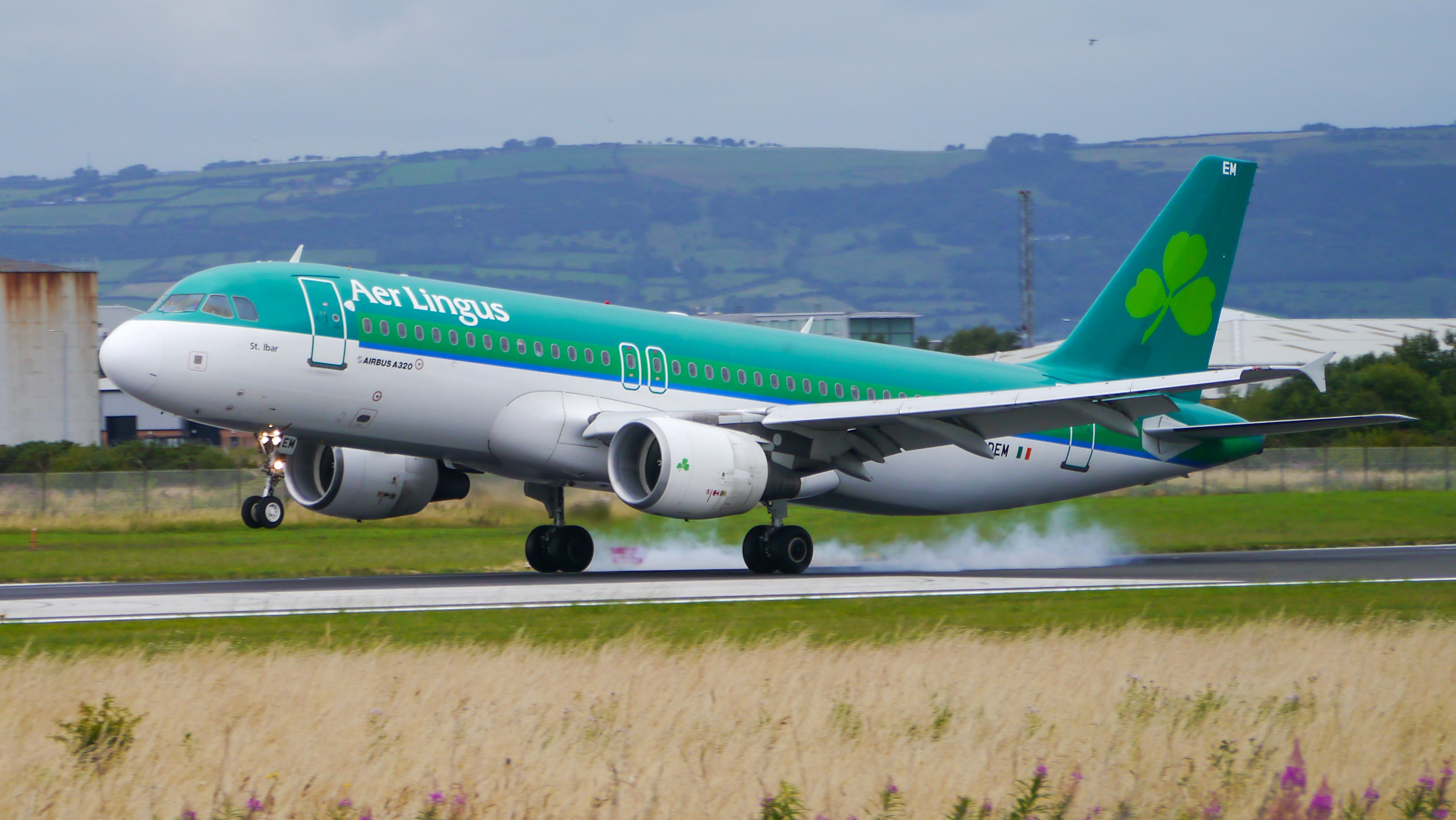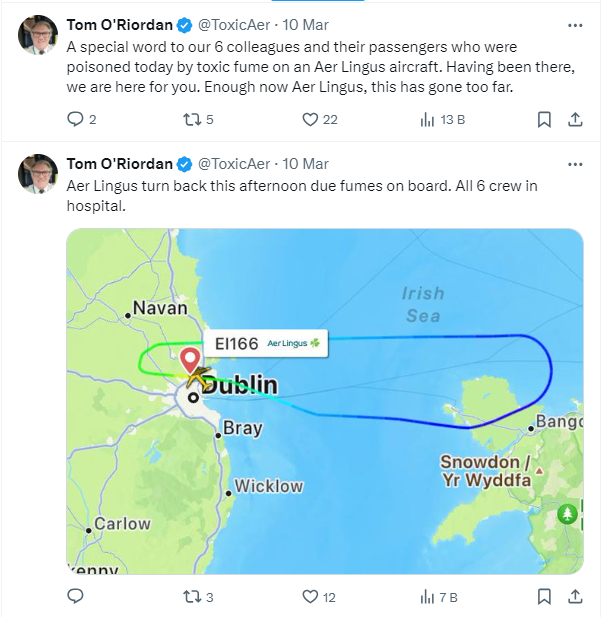Several Aer Lingus crew members on flight EI166 had reportedly been exposed to Toxic Fumes which forced the flight to make an emergency diversion back to Dublin. The crew members were hospitalized and are receiving treatment for potential fume inhalation.

The Incident
Aer Lingus flight EI166 operated by an Airbus A320 departed from Dublin Airport (DUB) at 1:25 p.m. local time on March 9 and was en route to London Heathrow (LHR), but less than an hour after taking off cabin crew members were allegedly exposed to "toxic fumes" which caused the aircraft to divert to Dublin Airport (DUB). The A320 was delivered to the Irish carrier in April 2005, Aer Lingus has 29 of them in their fleet which 27 are actively operating. According to the reports the plane reached 29,000ft over the Irish Sea and entered UK airspace, at which time the pilots contacted Air Traffic Control (ATC) to report the occurrence of "fumes".
According to a report by aviation news outlet AIRLIVE, pilots on the flight diverted back to DUB due to fumes originating from the plane's engines, as they suspected. The flight, which was only 42 minutes airborne, landed safely on runway 10. While some media reports claim six crew members and passengers were treated for smoke inhalation poisoning, it's unclear if any crew members received medical attention. An airline spokesperson provided the following statement to AIRLIVE.
"Yesterday, Aer Lingus flight EI166 to London Heathrow experienced a technical issue and returned to Dublin Airport, landing normally. No medical treatment was required for crew following assessment," they said and added that Aer Lingus “re-accommodated all passengers yesterday.”
.jpg)
A Previous Toxic Fume Incident
Tom O'Riordan, a former Aer Lingus captain claims that he was "poisoned by toxic air" while operating as a captain on an Aer Lingus flight and he took his concerns to X (formerly known as Twitter) by saying, "A special word to our 6 colleagues and their passengers who were poisoned today by toxic fume on an Aer Lingus aircraft. Having been there, we are here for you."

He also shared his own experience in a post:
"On June 5th, 2023, I was poisoned by toxic air fumes whilst operating EI-DEN from Lhr to Dub. Following which I was taken by ambulance to hospital and admitted for 5 days. I continue to live with serious symptoms related to this incident. I have attempted to get assistance from Aer Lingus and have received no assistance. I have learned that Aer Lingus experienced 22 reported fume events between January 2023 and January 2024, and that these incidents are on the increase. In September 2023, a technical notice related to fume events was issued to Aer Lingus engineers. No information on fume incidents have been disseminated to crew or passengers. I have previously asked for fair compensation for myself, the dissemination of information on fume events and a health protocol for persons who have been subjected to a fume events. Also, I requested that persons who are now living with effects of fume events be openly and fairly engaged. None of this has happened."
Aerotoxic Syndrome poses a health risk for passengers and crew on airplanes. This condition arises when leaks or malfunctions allow engine oil or hydraulic fluids, which can contain harmful toxins, to contaminate the plane's air supply. While the exact frequency of Aerotoxic Syndrome remains unclear due to a lack of transparent reporting by some airlines, all carriers must take this issue seriously. By implementing stricter maintenance protocols, investing in improved air filtration systems, and open communication about potential incidents, airlines can prioritize the well-being of everyone onboard.
Comments (1)
 Andrew Peacher
Aerotoxic Syndrome The Airline Pilot's story Leonard Lawrence Share and comment
https://www.youtube.com/watch?v=JawwGXeqD80
Andrew Peacher
Aerotoxic Syndrome The Airline Pilot's story Leonard Lawrence Share and comment
https://www.youtube.com/watch?v=JawwGXeqD80
Add Your Comment
SHARE
TAGS
NEWS Aer LingusToxic AirIncidentEmergency LandingMedical AssistanceAviation NewsAirline IncidentAirbusAirbus A320RECENTLY PUBLISHED
 Learjet Owned By Vince Neil Crashes Into Gulfstream Jet, 1 Fatality Confirmed
On February 10th, around 14:30 local time, a Learjet private jet aircraft crashed into another private jet after landing at Scottsdale Airport (SCF) in Arizona.
NEWS
READ MORE »
Learjet Owned By Vince Neil Crashes Into Gulfstream Jet, 1 Fatality Confirmed
On February 10th, around 14:30 local time, a Learjet private jet aircraft crashed into another private jet after landing at Scottsdale Airport (SCF) in Arizona.
NEWS
READ MORE »
 Seattle Plane Strike 2025: Japan Airlines and Delta Collision Raises Safety Concerns
Seattle-Tacoma International Airport saw a concerning incident on Wednesday morning when a Japan Airlines (JAL) plane clipped a parked Delta Air Lines jet while taxiing. Thankfully, no one was injured, but passengers described the collision as a frightening experience.
NEWS
READ MORE »
Seattle Plane Strike 2025: Japan Airlines and Delta Collision Raises Safety Concerns
Seattle-Tacoma International Airport saw a concerning incident on Wednesday morning when a Japan Airlines (JAL) plane clipped a parked Delta Air Lines jet while taxiing. Thankfully, no one was injured, but passengers described the collision as a frightening experience.
NEWS
READ MORE »
 Ethiopian Airlines Expands Cargo Fleet with New Boeing 777 Freighter
Ethiopian Airlines has expanded its cargo fleet with a brand-new Boeing 777 Freighter, registered as ET-BAB (MSN 68140). The aircraft was delivered directly from Boeing’s factory in Everett, Washington, USA, and landed at Addis Ababa Bole International Airport at 3:41 PM (GMT+3) on Wednesday, January 22, 2025.
NEWS
READ MORE »
Ethiopian Airlines Expands Cargo Fleet with New Boeing 777 Freighter
Ethiopian Airlines has expanded its cargo fleet with a brand-new Boeing 777 Freighter, registered as ET-BAB (MSN 68140). The aircraft was delivered directly from Boeing’s factory in Everett, Washington, USA, and landed at Addis Ababa Bole International Airport at 3:41 PM (GMT+3) on Wednesday, January 22, 2025.
NEWS
READ MORE »





